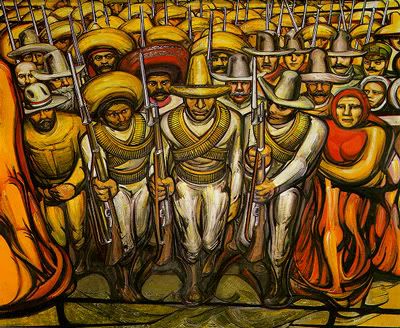Before the civil war even began President Porfirio Diaz was still in control, and the sugar cane business was expanding. To accommodate these needs, the land of the people who lived in those villages was taken away and they were forcibly made to work for the plantations that at one point use to be their homes (The University of Tennessee).
“In 1910, Francisco Madero, a son of wealthy plantation owners, instigated a revolution against the government of president Diaz. Even though most of his motives were political…, Madero’s revolutionary plan included provisions for returning seized land to peasant farmers” (The University of Tennessee). When Madero said this it ignited more people to want to join the rebellion mainly attracting peasants because they were tired of being unfairly treated because of their social status (The University of Tennessee).
He dressed like a cowboy and wasn’t as poor as the rest of the villagers, but all the same he disagreed with the malevolent way the government was going about (The University of Tennessee). “Emiliano Zapata was orphaned at 16, he share cropped and traded horses in his birthplace. During the closing years of the Porfirio Diaz dictatorship Zapata took part in local opposition politics, with a 6-month interruption while he served as a soldier” (Encyclopedia of World). In September 1909 Zapata was elected as president of Anenecuilco his main job was to get the community’s land back. They tried to get Porfirio Diaz out of office but when that failed Zapata got involved in the rebellion (Encyclopedia of World).
One important event that Zapata was involved in was the attempt to overthrow the dictator Porfirio Diaz. When he heard of Madero going against Porfirio Diaz he recruited his own army of people, known as the Zapatistas, to join Madero’s army. They got rid of Porfirio Diaz and Madero was placed in control (The Columbia Encyclopedia). “Zapata supported Madero until he thought that land reform had been abandoned, then he returned and formulated his own agrarian program. This program outlined in the Plan of Ayala…, called for the return of the land to the indigenous people” (The Columbia Encyclopedia). The peasants stood behind Zapata and by 1911 he controlled most of Morelos and he was in the south leader while Villa was the leader of the south. In his final years he protected Morelos and redistributed land until his killing (The Wind That).
The impression that Zapata had left stayed with the people but from the start he knew he would not be able to see the war end the whole way through, evidence of this was when Zapata said “I must tell you that I will not see this revolution end, because those who initiate great causes don’t see them end …” (Discovering Biography). After he was killed many did not believe it was Zapata, when he died the war was not yet over. The people he left behind did not forget him and still carried on with what he was trying to accomplish (Encyclopedia of World). Who took his place was Gildardo Magaña he negotiated with Carranza and didn’t follow through with the Plan of Ayala but instead negotiated for peace (Discovering Biography).
Emiliano Zapata is recognized as a man who helped out in the Mexican Revolution. The main purpose of the entire Mexican revolution was to show that not just the government gets to decide what happens to its people but that the people also have a say (Discovering Biography). Zapata was not a national hero when he died and many of the goals he wanted were not completely achieved, however his ideals stayed with the people and even though they had not fully won hope was still there. Even in the later years in the 1990’s when President Carlos Salinas de Gortari decided to abandoning the changes in article 27 of the Constitution of 1917 which was said to have been inspired by what Emiliano Zapata had wanted to accomplish. The president tried to interpret a new meaning to what Zapata had said but peasants disagreed and a new improved Zapatismo group known as Ejército Zapatista de Liberación Nacional protested against government. his image over time became more heroic then when he was alive because compared to the other revolutionaries he was always single minded (Brunk, Samuel).
His reasons for fighting in the Mexican revolution were pure his main goal always stayed the same which was to give the land back to its rightful owners. Emiliano Zapata affected the future after he left because he gave people courage to speak out. He also helped improve the living circumstances in Mexico. Zapata will always be remembered as one of the many famous people who helped change Mexico.
Works Cited
BrainyMedia.com. “Emiliano Zapata Quotes”. 2008. 15 Oct.2008 <
http://www.brainyquote.com/quotes/authors/e/emiliano_zapata.html>
Brunk, Samuel. “The Posthumous Career of Emiliano Zapata Myth, Memory, and
Mexico's Twentieth Century”. University of Texas Press. 2003. 27 Oct. 2008 <>
Encyclopedia of World Biography. “Emiliano Zapata.” 2008. 15 Oct. 2008
<>
The Columbian Encyclopedia, Sixth Edition. “Emiliano Zapata” 2008. 15 Oct. 2008 <
http://www.encyclopedia.com/doc/1E1-Zapata-E.html>
The University of Tennessee. “Emiliano Zapata Father of the Zapatista Movement.” 15
Oct. 2008 <>
"The Wind That Swept Mexico." The Hispanic American Experience. American Journey
Online. Woodbridge,
CT.: Primary Source Microfilm, 1999. Student Resource Center - Gold. Gale. HIGH TECH CHARTER HIGH SCHOOL. 15 Oct. 2008
"Zapata, Emiliano (1879-1919)." Discovering Biography. Online ed. Detroit: Gale,
2003. Student Resource
Center - Gold. Gale. HIGH TECH CHARTER HIGH SCHOOL. 15 Oct. 2008


